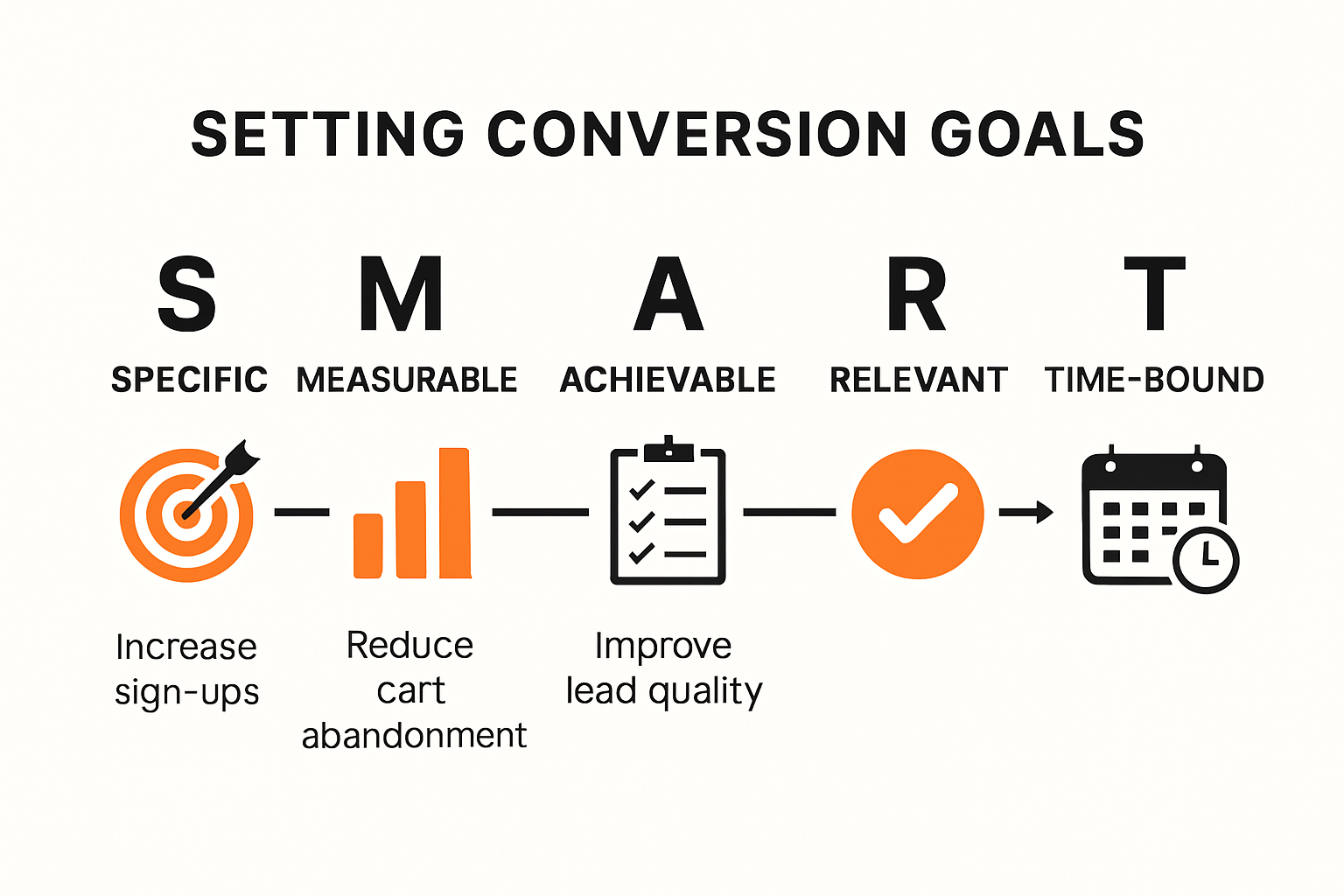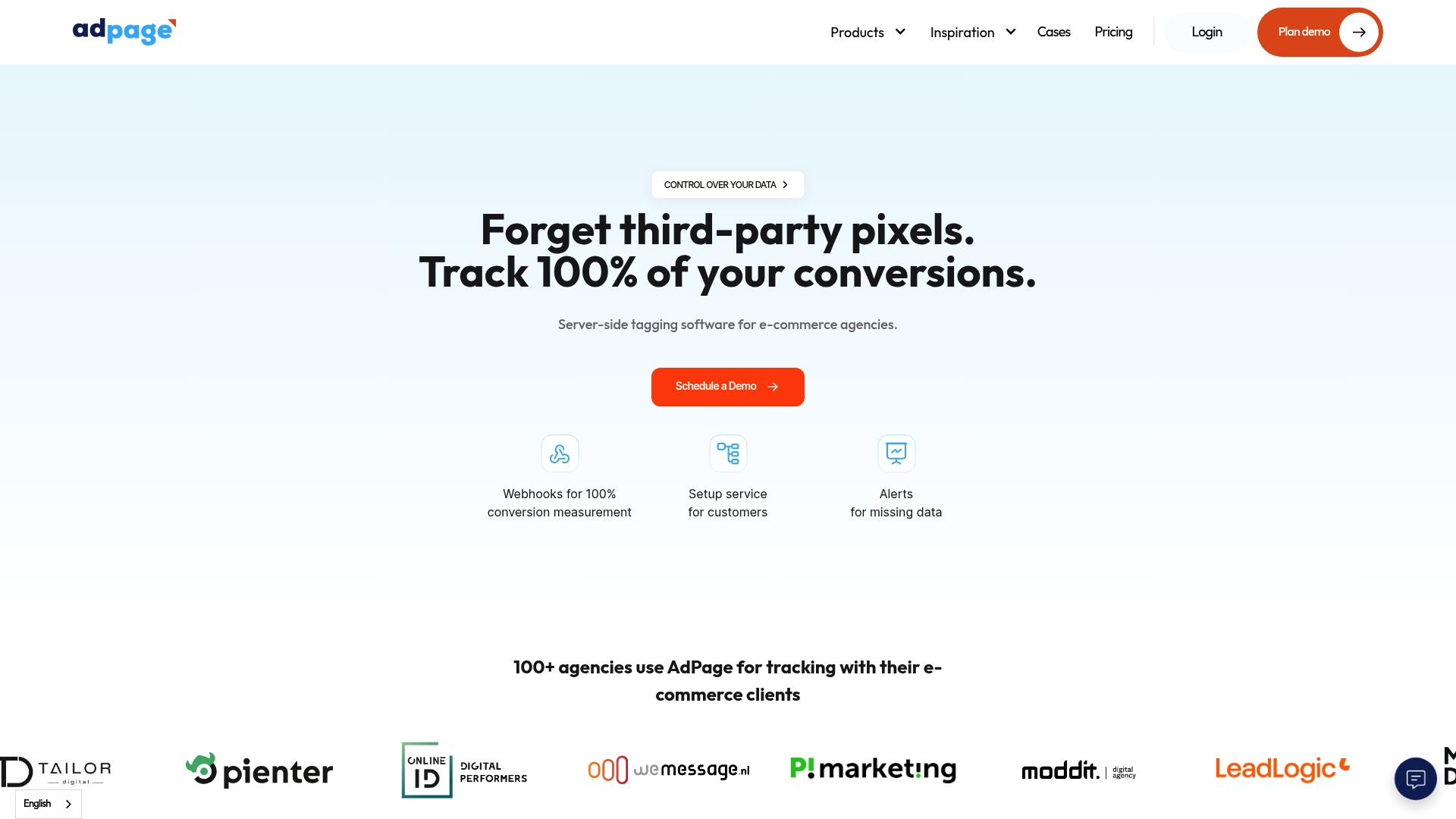Marketers pour resources into attracting visitors, hoping each click turns into business growth. Yet just measuring visits tells you very little. Shockingly, over 95 percent of web visitors leave without taking any desired action at all. So the real power comes not from counting visitors, but from setting sharp conversion goals that reveal exactly what sparks true customer engagement.
Table of Contents
- Understanding What Conversion Goals Mean
- Why Conversion Goals Matter In Digital Marketing
- How To Set Effective Conversion Goals
- Best Practices For Tracking And Improving Goals
Quick Summary
| Takeaway | Explanation |
|---|---|
| Define Specific Conversion Goals | Clearly specify the actions you want users to take. Focus on measurable outcomes that align with your business objectives. |
| Use SMART Criteria for Goal Setting | Ensure that conversion goals are Specific, Measurable, Achievable, Relevant, and Time-bound. This structure helps in effective tracking and assessment. |
| Implement a Comprehensive Tracking Framework | Establish a robust measurement infrastructure and select appropriate analytics tools to understand user interactions deeply. |
| Continuous Data Analysis is Essential | Regularly review performance metrics and make data-driven adjustments to optimise marketing strategies. This promotes a culture of learning and improvement. |
| Align Marketing with Business Outcomes | Ensuring your conversion goals reflect broader business objectives facilitates a clearer understanding of marketing effectiveness. |
Understanding What Conversion Goals Mean
Conversion goals represent strategic objectives that businesses establish to measure the success of their digital marketing efforts and track meaningful user interactions. These goals transform abstract website traffic into concrete, actionable insights about user behaviour and marketing performance.
The Core Definition of Conversion Goals
At its fundamental level, a conversion goal is a specific action that a business wants website visitors or potential customers to complete. Learn more about tracking critical conversions and understand why these metrics matter. According to Kennesaw State University’s Strategic Communications and Marketing department, conversion occurs when a viewer performs a desired action such as clicking an advertisement, filling out a form, downloading content, or making a purchase.
Conversion goals can vary dramatically across different industries and business models. For an e-commerce platform, a conversion might mean completing a product purchase. For a software company, it could involve signing up for a free trial. For a content website, downloading a whitepaper or subscribing to a newsletter might constitute a conversion.
Why Conversion Goals Matter
Defining precise conversion goals enables businesses to move beyond vanity metrics like pageviews or site visits and focus on meaningful interactions that drive genuine business value. As George Mason University’s Web Analytics team advises, setting up goals in analytics platforms allows organisations to track website success based on bottom-line metrics.
By establishing clear conversion goals, marketers can:
- Measure Marketing Effectiveness: Understand which channels, campaigns, and strategies genuinely drive desired user actions.
- Optimise User Experience: Identify potential friction points in the conversion process and improve website design.
- Allocate Resources Strategically: Focus budget and efforts on tactics that demonstrably contribute to business objectives.
Understanding conversion goals transforms raw web traffic data into strategic intelligence, enabling businesses to make informed decisions about their digital marketing investments and user engagement strategies.
Why Conversion Goals Matter in Digital Marketing
In the complex world of digital marketing, conversion goals serve as critical navigational tools that transform ambiguous online interactions into measurable, strategic business outcomes. They provide organisations with a precise mechanism to understand, evaluate, and optimise their digital marketing performance.
Aligning Marketing Efforts with Business Objectives
Learn about essential online marketing strategies to comprehend how conversion goals bridge the gap between marketing activities and business results. According to Southern New Hampshire University, understanding your audience, creating valuable content, and measuring results are fundamental to successful digital marketing.
Conversion goals enable businesses to translate abstract marketing efforts into concrete metrics that directly reflect organisational priorities. Whether the objective is generating leads, increasing sales, or building brand awareness, these goals provide a structured framework for assessing marketing effectiveness.
Strategic Performance Measurement
The LibreTexts Business resource emphasises the importance of setting SMART objectives—Specific, Measurable, Achievable, Relevant, and Time-bound—as crucial for guiding digital marketing strategies.
By implementing well-defined conversion goals, businesses can:
- Quantify Marketing Impact: Transform qualitative marketing efforts into quantifiable data points that demonstrate real business value.
- Resource Allocation: Identify which marketing channels and campaigns generate the most meaningful user interactions.
- Continuous Improvement: Use data-driven insights to refine marketing strategies and enhance overall digital performance.
Moreover, conversion goals provide a holistic view of user behaviour, enabling marketers to understand the complete customer journey. They reveal critical insights about user engagement, pinpoint potential friction points, and highlight opportunities for optimisation.
Ultimately, conversion goals are not merely tracking mechanisms but strategic tools that empower businesses to make informed decisions, maximise marketing investments, and drive sustainable growth in an increasingly competitive digital landscape.
How to Set Effective Conversion Goals
Establishing effective conversion goals requires a strategic approach that transforms broad business objectives into precise, measurable targets. The process demands careful planning, deep understanding of business priorities, and a systematic method for tracking meaningful user interactions.
Defining Clear and Specific Goals
Discover expert strategies for tracking conversions and understand the nuances of goal setting. According to the Substance Abuse and Mental Health Services Administration, effective goals should state an expected, measurable outcome, address specific behaviors or conditions, define the target audience, and remain concise.
When crafting conversion goals, businesses must consider multiple dimensions. A well-defined goal might specify not just the desired action, but also the expected volume, timeframe, and potential impact on overall business performance. For instance, instead of a vague goal like “increase website sales,” a more effective goal would be “increase online product purchases by 15% within the next quarter through targeted email marketing campaigns”.
Implementing the SMART Criteria
The U.S. Office of Personnel Management recommends a structured approach to goal setting that emphasizes clarity, measurability, and achievability. The SMART framework provides a robust methodology for developing conversion goals:
To help clarify the differences between the SMART criteria for setting conversion goals, here is a summary table outlining each element and its meaning in a goal-setting context.
| SMART Element | Description |
|---|---|
| Specific | Clearly define what exactly needs to be accomplished |
| Measurable | Establish concrete criteria for measuring progress |
| Achievable | Ensure goals are realistic and attainable |
| Relevant | Align goals with broader business objectives |
| Time-bound | Set clear deadlines and timeframes |

- Specific: Clearly define what exactly needs to be accomplished
- Measurable: Establish concrete criteria for measuring progress
- Achievable: Ensure goals are realistic and attainable
- Relevant: Align goals with broader business objectives
- Time-bound: Set clear deadlines and timeframes
The RAND Corporation’s ‘Getting to Outcomes’ guide further emphasizes that each goal should articulate the precise change an organisation aims to achieve. This means moving beyond generic targets and developing outcome statements that provide genuine insight into performance.
For digital marketers, this might translate into goals such as:
- Increasing newsletter sign-ups by 20% in the next two months
- Reducing cart abandonment rates by 10% through improved checkout design
- Improving lead qualification conversion rates from 2% to 4% by refining lead nurturing strategies
Successful conversion goal setting is an iterative process that requires continuous refinement. By maintaining flexibility, regularly reviewing performance metrics, and adapting strategies based on data-driven insights, businesses can create a dynamic framework for measuring and improving their digital marketing effectiveness.
Best Practices for Tracking and Improving Goals
Tracking and improving conversion goals requires a systematic approach that combines data analysis, strategic thinking, and continuous refinement. Successful marketers understand that goal tracking is not a one-time activity but an ongoing process of measurement, analysis, and optimization.
Establishing a Comprehensive Tracking Framework
Learn how to build an effective tracking strategy that captures meaningful insights about your digital performance. According to the Office of Natural Resources Revenue, integrating metrics with annual goals requires strategic alignment of measurement criteria across different categories such as data, content, accessibility, customer experience, technical aspects, and outreach initiatives.
Effective tracking begins with creating a robust measurement infrastructure. This involves selecting appropriate analytics tools, defining key performance indicators (KPIs), and establishing a systematic approach to data collection and interpretation. Marketers must ensure that their tracking mechanisms can capture granular details about user interactions, providing a comprehensive view of the conversion journey.
Implementing Advanced Tracking Techniques
The Digital Services & Solutions recommends a strategic approach to tracking that goes beyond basic metrics. This includes developing a sophisticated content model, defining content types and attributes, and considering comprehensive user journeys.
Key advanced tracking techniques include:
Below is a summary table of advanced tracking techniques, with corresponding descriptions, to illustrate options for comprehensive marketing goal measurement.
| Tracking Technique | Description |
|---|---|
| Segmentation | Breaking down conversion data by user demographics, traffic sources, and device types |
| Funnel Analysis | Identifying specific points of friction in the user conversion path |
| Multi-Channel Attribution | Understanding how different marketing channels contribute to final conversions |
| Real-time Monitoring | Implementing dashboards that provide immediate insights into goal performance |
- Segmentation: Breaking down conversion data by various dimensions such as user demographics, traffic sources, and device types
- Funnel Analysis: Identifying specific points of friction in the user conversion path
- Multi-Channel Attribution: Understanding how different marketing channels contribute to final conversions
- Real-time Performance Monitoring: Implementing dashboards that provide immediate insights into goal performance
Continuous improvement requires a proactive approach to data analysis. This means regularly reviewing performance metrics, identifying trends, and making data-driven adjustments to marketing strategies. Successful organizations create a culture of continuous learning, where insights from conversion tracking inform broader business decisions.
The most effective tracking strategies are those that remain flexible and adaptive. As digital marketing landscapes evolve, businesses must be prepared to refine their goals, update their tracking methodologies, and embrace new technologies that provide deeper insights into user behaviour. By maintaining a commitment to data-driven optimization, organisations can transform their conversion goals from static targets into dynamic tools for sustained business growth.

Frequently Asked Questions
What are conversion goals in digital marketing?
Conversion goals are specific actions that businesses want website visitors or potential customers to complete, such as filling out a form, making a purchase, or signing up for a newsletter. They serve as metrics to measure the effectiveness of marketing efforts.
Why are conversion goals important for marketers?
Conversion goals allow marketers to move beyond mere traffic numbers and focus on meaningful interactions that drive genuine business value. They help in measuring marketing effectiveness, optimising user experience, and strategically allocating resources.
How can businesses set effective conversion goals?
To set effective conversion goals, businesses should define clear and specific objectives, implement the SMART criteria (Specific, Measurable, Achievable, Relevant, Time-bound), and continuously review their performance to refine their strategies based on data.
What are some best practices for tracking conversion goals?
Best practices for tracking conversion goals include establishing a comprehensive tracking framework with appropriate analytics tools, implementing advanced tracking techniques like segmentation and funnel analysis, and regularly reviewing data to inform marketing adjustments.
Take Control of Your Conversion Goals Today
Are you putting in the effort to set clear conversion goals yet finding your tracking lacks precision? This guide highlights how unreliable analytics and missing visitor data can block your ability to measure what really matters—actual conversions. The frustration of untracked sales and inaccurate reports means missed opportunities and wasted budget. You already know that focusing on true customer actions, from purchases to sign-ups, is the key to growth. Now imagine having complete clarity and confidence in every result.

With AdPage, you can ensure that 100 percent of your conversions are captured, even as data privacy restrictions increase and analytics tools fall short. Our robust server-side tagging, consent management and e-commerce integrations empower you to set and achieve precise conversion goals while staying fully compliant with GDPR. Do not settle for guesswork—take the lead and optimise your marketing results. Get started by visiting AdPage’s platform now and unlock the full power of actionable data.



.png)
